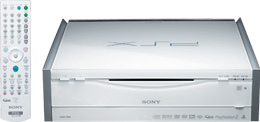More manufacturers are producing multi-format DVD burners than ever before and prices for the hardware are falling rapidly. Some of the uncertainty has been taken out of the format as Sony and Pioneer make drives that support both DVD-R/RW and DVD+R/RW disk creation and reading.
However, 16x drives (rotating at 10,800 revolutions per second!) are near the maximum speed possible for DVD, so since we can spin the disk much faster, the next battle is to fit more on the disk. Storing data more densely on the layer will allow faster read times (the laser doesn’t have to travel so far) and higher capacities (smaller pits mean more data in the same area).
Double-sided, double-layer disks are possible (DVD-18) but are currently expensive to produce – though DVD mastering techniques (both home burning and commercial production, though these use completely different techniques) are improving all the time. Dual-layer disks used to be much more expensive to produce than they are now – remember the first DVDs you bought where you had to flip the disk over half way through the film? Cheaper mastering techniques were so that Warner Brothers could sell yo that disk for £25 and still make a profit – never mind you had to get out of your seat half way through Goodfellas.
The next format up will be Blu-ray, from the Blu-ray Disk Founders (BDF – including Dell, Hewlett Packard, Hitachi, LG, Philips, Pioneer and Sony amongst others). As the name suggests, Blu-ray uses a blue laser to read data. Blue light has a shorter wavelength, so can read smaller pits – and tha means denser data: a dual-layer disk will store 50gb. As the data pattern is s intricate, this makes them more vulnerable to data destroying scratches. The format is currently available in Japan and the USA, but the disks are cartridge based – the next iteration of the format will not use a cartridge as it will have a coating supplied by TDK.
Naturally, the step to the next level will not be that simple: NEC and Toshiba are promoting HD DVD at CeBIT. This new format uses the same optical head as a conventional DVD player, and a dual-layer disk will store 30gb. Look forward to seeing HD DVD burners on the market in 2005.
We hope that backwards compatibility is high on each one of these manufacturers’ lists.
Sony’s domestic Blu-ray recorder
DVD Demystified on the five (no, six! Isn’t it seven?) proposed for high density disks
 Following the recent launch of Sony’s PSX, which combines the functions of a PlayStation 2, PVR and DVD burner (
Following the recent launch of Sony’s PSX, which combines the functions of a PlayStation 2, PVR and DVD burner ( After a number of months of speculation, Sony have released the full details the PSX. Combining the ability to play PlayStation games with a television tuner, PVR, ATRAC3/MP3 playback and a DVD player/recorder, the box will also be equipped with a 100Mb Ethernet port – opening the door to the delivery of digital media.
After a number of months of speculation, Sony have released the full details the PSX. Combining the ability to play PlayStation games with a television tuner, PVR, ATRAC3/MP3 playback and a DVD player/recorder, the box will also be equipped with a 100Mb Ethernet port – opening the door to the delivery of digital media.